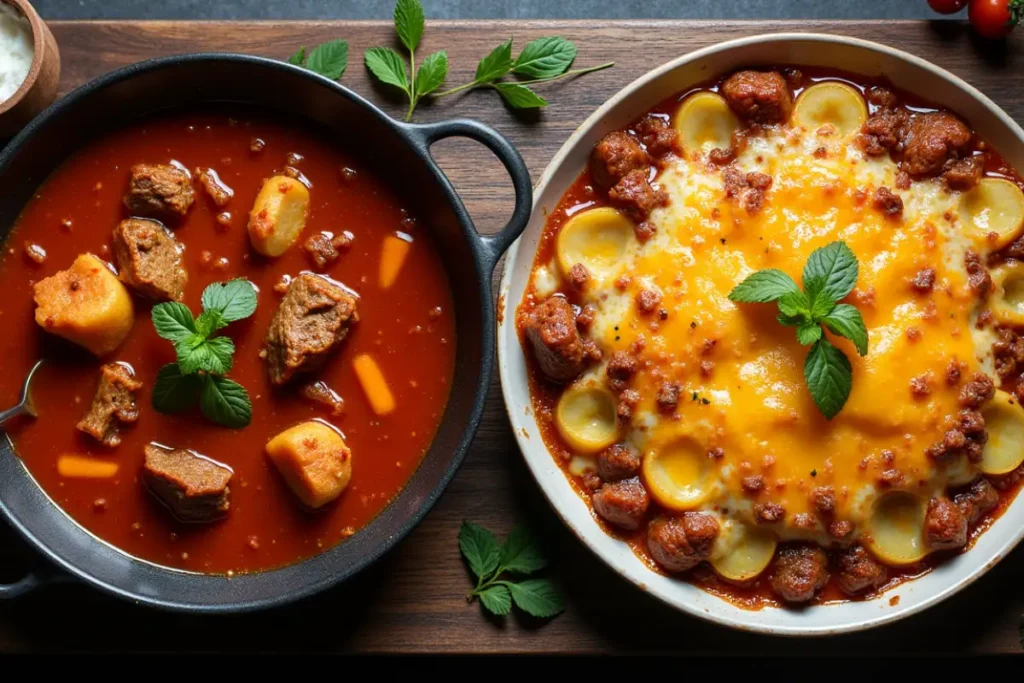Table Of Contents
Table of Contents
Understanding Stews and Casseroles: What Sets Them Apart?
What Is a Stew?
Definition and Characteristics
A stew is a slow cooking and a liquid base to make a delicious, hearty dish. It includes ingredients such as vegetables, meat, and spices that simmer over the flame at a lower temperature. This method allows the flavors to blend while softening tougher pieces of beef. Stews can make dishes that are rich, warming, and suitable for colder weather.
Typical Ingredients Used in Stews
It is possible to make stews using numerous ingredients, which allows for flexibility according to the available ingredients or your personal preferences. Common ingredients include:
- Proteins Cuts of tough lamb, beef, pork, or chicken melt beautifully in the slow cooking process. Tofu, a plant-based protein, can also work great.
- Vegetables The root vegetables like carrots, potatoes, and parsnips provide the texture and sweetness. Tomatoes, celery, and leafy greens give flavor and color.
- Liquid Base The broth, stock, or wine serves as the base for the dish. It can be enriched by tomato paste to add richness.
- Spices Garlic thyme and rosemary leaves help bring out the best qualities of the ingredients, and spices like chili powder or paprika give a kick.
Cooking Process of Stews
To make a stew, take these instructions:
- Cook the meat: Sear the meat in a frying pan to create a caramelized base which enhances the flavor overall.
- Include Aromatics Prepare onions, garlic, and various other spices to develop a flavorful profile.
- Mix Ingredients: Add the vegetables as well as liquid and herbs Then cover the pot.
- Slowly simmer: Cook over low temperatures, allowing the food to dissolve and increase the thickness of the liquid naturally.
To make things easier, make use of a slow cooker or pressure cooker to achieve the same results but with less.
What Is a Casserole?
Definition and Characteristics
A casserole is a one-dish dinner that cooks completely by baking in an oven. It is typically made up of the ingredients of vegetables, protein along starches, as well as a binder to hold the entire thing together. The result is a meal that has a well-defined texture usually topped with a crispy or cheese-laden layer. Contrary to stews, casseroles depend on dry heat, not simmering liquids.
Casseroles are popular with busy households because they are easy to prepare, require only minimal clean-up, and are served in a complete meal.
Common Ingredients in Casseroles
Casseroles provide a variety of creative ingredients while ensuring the balance between proteins, starch, and veggies. Some of the most popular options are:
- Proteins Chunks of chicken that have been shredded, ground turkey, ground beef, or plant-based proteins such as lentils or beans.
- vegetable: Broccoli, peas as well as mushrooms and zucchini add protein and starches.
- starches Rice, pasta, or potatoes that are thinly cut are the basis.
- Binders The bechamel sauce or cream-based soups bring all the ingredients together.
- Toppers: Shredded cheese, breadcrumbs fresh herbs, or shredded cheese give the texture and taste.
Casserole Preparation and Baking
To prepare a dish Follow these easy steps:
- Pre-Cook Ingredients Prepare starches and proteins before putting them in the dish.
- To assemble the dish: Layer or mix ingredients in a baking dish, making sure to ensure an even distribution.
- Add a topping: Sprinkle breadcrumbs, cheese, or even herbs on the top to add crunch and flavor.
- Bake The casserole is cooked in an oven preheated until golden brown and bubbly.
For a concrete illustration of how casseroles can be a hearty, budget-friendly option read our in-depth guide to Hobo Casserole recipe: hearty budget-friendly comfort food. This recipe is a perfect example of the ingredients that make casseroles a mainstay in the world of comfort food.
Key Differences Between Stews and Casseroles

Cooking Methods
- Stews The stew can be simmered over the stove or in the Dutch oven or slow cooker. The liquid will soften the ingredients as it cooks.
- Casseroles: Baked in the oven, with dry heat, to get the texture of solid and firm layers.
Consistency and Texture
- Stews are characterized by a heavy, liquid consistency that is perfect to pair with rice or bread.
- Casseroles feature a more sturdy form and often have a smooth interior and crisp topping.
Serving Style
- They are usually served with bowls and are usually served with sides such as crunchy bread.
- Casseroles can be cut or scooped in the oven dish.
Stews and Casseroles in Global Cuisine
Stews Across Cultures
Culinary traditions around the world have embraced stews because of their comfort, simplicity, and flexibility. Their versatility lets cooks mix local ingredients and tastes which can lead to numerous regional variations. From delicious European classics to lively African and Caribbean stews, stews highlight the distinct culinary traditions of each country. Some of the most memorable examples are:
- French Food: Boeuf Bourguignon features beef that is simmered in red wines with onions and mushrooms.
- Moroccan cuisine: Tagine combines tender meats with spices and fruits that are cooked in a special clay pot.
- Caribbean Cuisine: Pepper pot contains Cassava and spices that are rich and offer bold flavors.
Casseroles Through Time
Casseroles became popular in the 20th century because of their ease of use and versatility. Examples include:
- American Classics: Green tuna noodles and bean casserole are still holiday staples.
- Mexican Inflection: Enchilada casserole layers tortillas with beans, cheese, and salsa to give it spice.
- Greek Moussaka It is a dish that combines ground meat and eggplant served with a bechamel sauce.
Nutritional Comparison of Stews and Casseroles
| Nutritional Aspect | Stews | Casseroles |
|---|---|---|
| Calories | Generally lower due to broth-based liquids and fewer starches. | Typically higher because of creamy, cheesy, and starch-rich bases. |
| Macronutrient Balance | Lean proteins, fiber from vegetables, and minimal added fats. | More fats and carbohydrates due to ingredients like cheese, cream, and pasta. |
| Healthier Choices | – Use lean proteins and plenty of vegetables for fiber. – Cut down on added fats. – Focus on fresh herbs for flavor. | – Opt for low-fat dairy or dairy substitutes. – Use whole-grain starches or eliminate starches. – Reduce cream and cheese to lower calories. |
Tips for Perfecting Stews and Casseroles
Secrets to a Flavorful Stew
- Sear the meat to add depth to the flavor base.
- Layer ingredients in a strategic way by adding liquids and vegetables slowly.
- Allow the stew to rest for a few minutes following cooking to intensify its flavor.
Crafting a Delicious Casserole
- Prepare the key ingredients such as proteins and starches to help the food cook uniformly.
- Sprinkle each layer with salt and pepper to avoid stale bites.
- Serve with a topping such as cheese or breadcrumbs to increase the appeal of the texture and appearance of the dish.
FAQs About Stews and Casseroles
Can I turn a stew into a casserole?
Yes! When you thicken the stew by adding flour or cornstarch, and then moving it into baking dishes and then adding the garnish and cook it until you have an a la mode dish.
Which is the best dish to prepare meals?
Both are great for meal preparation, However, casseroles tend to be more prone to freezing and heating easily because of their arranged nature.
What is the best cookware to use for all?
For stews, you’ll require a Dutch oven or a large-bottomed pot. On the contrary, casseroles need oven-safe dishes, such as Pyrex as well as ceramic bakeware.
Conclusion
The comfort of stews and casseroles is brought by their simplicity and flexibility to the kitchen. It doesn’t matter if you prefer the warm broth-based flavor of stew or the comfort of baked casseroles each has its unique advantages. If you understand the differences between the two and master the art of cooking them, it is possible to create meals that please all palates. Explore the various ingredients and methods to make these classic dishes your own.



